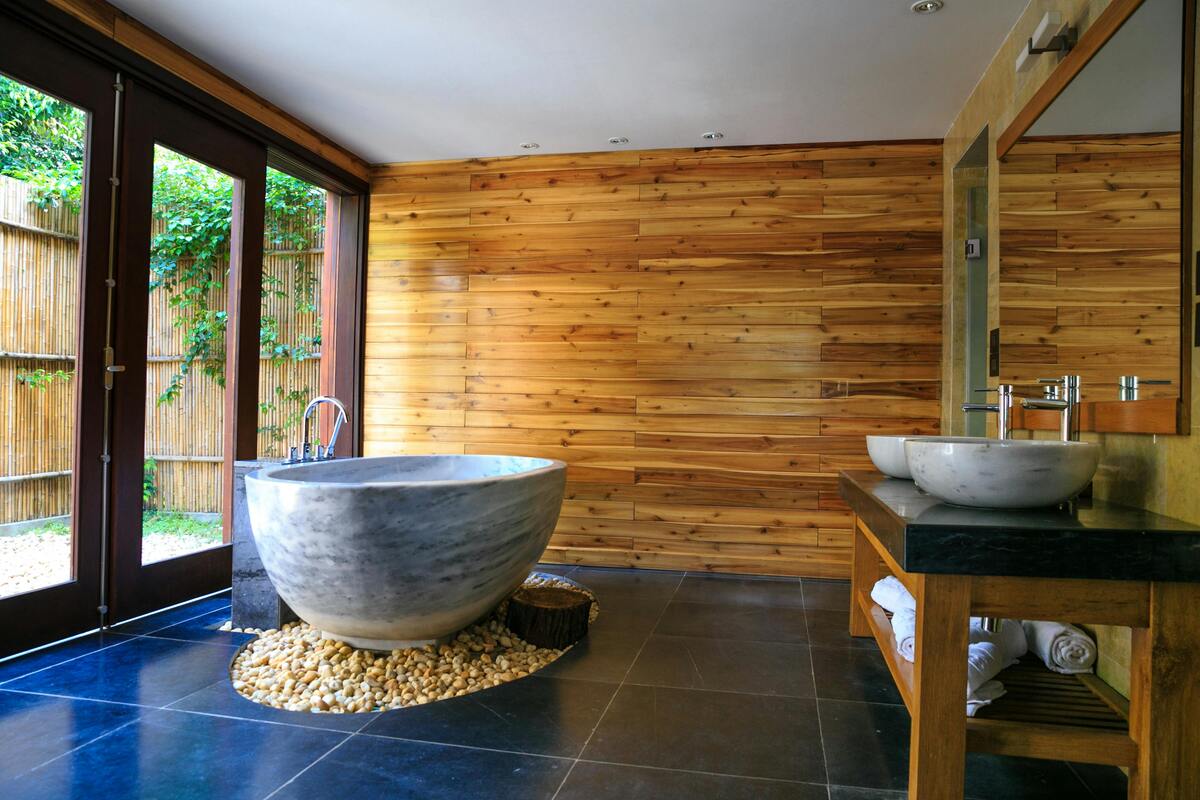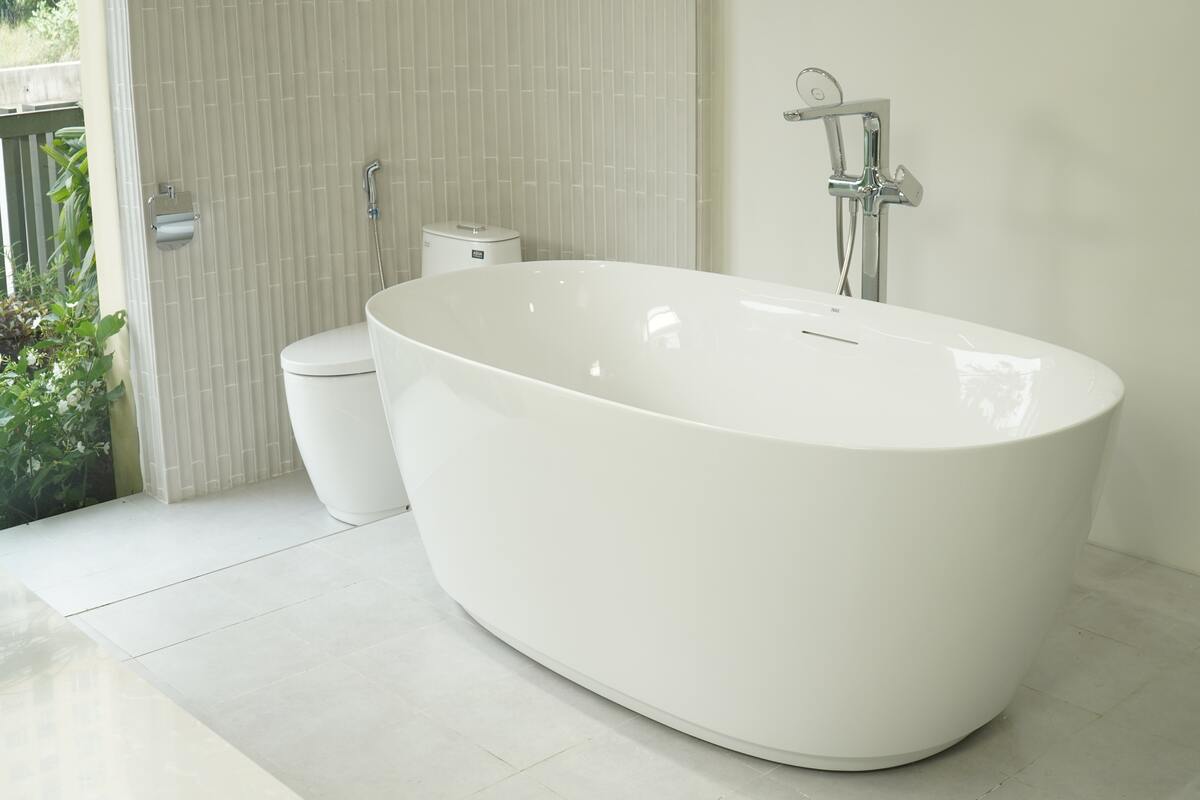Japanese Bathroom Guide: How To Design A Japanese Style Bathroom

Japanese bathrooms stand out for their practicality, cleanliness and attention to comfort. They support both daily routines and relaxation, with clear separation between washing and soaking.
It’s a striking, rewarding, unique style so in this guide, we explore how to design a Japanese bathroom – and there are some great principles you can embrace with less effort, without a full bathroom redesign, too.
This focus on thoughtful design and cleanliness turns an everyday activity into something relaxing and enjoyable.
It also explains why many people consider Japanese bathrooms among the most well-designed in the world.
A popular feature is the deep soaking tub, which stays filled with clean water that more than one person can use. Everyone washes thoroughly before getting in, so the water remains fresh and doesn’t need replacing after each person!
Bathroom interior design and Japanese culture
Taking a bath in a Japanese house is meant to be a similar experience to taking a bath at an onsen hot spring or a public bath, where the focus lies on soaking and relaxing after a proper wash. Sitting on a stool while rinsing the body before entering the tub is a standard part of this ritual.
The layout of a typical Japan home often reflects this mindset. Unlike many Western bathrooms, Japanese ones often divide the toilet and bathing areas into separate rooms.
This layout keeps the bathing space cleaner and helps preserve the calm atmosphere many associate with bathing in Japan.
In Japanese culture, the bathroom plays an important part in overall wellbeing for both cleansing and then relaxation. Separating cleansing and relaxation into subsequent steps also lets several people use the bath water in succession.
In homes, it’s common to find control panels on the wall for adjusting water temperature or reheating bath water. Some even include timers and automated filling to match personal schedules.
Japanese bathroom design: How to create a Japanese style bathroom
Relaxation and tranquility are important themes in Japanese bathroom design:
- Japanese bathroom design emphasises clean lines and uncluttered spaces.
- Earth tones and neutral palettes dominate in Japanese bathroom design e.g. on ceramic tiles
- And also, Japanese bathrooms often incorporate the use of natural materials such as wood, bamboo, stone, or pebbles. Stone flooring in Japanese bathrooms creates a natural, earthy feel.
- Japanese bathroom design often features water elements to create a calming effect. Zen elements, like small rock gardens or sand features, are often incorporated for a tranquil aesthetic.
- Japanese bathrooms often include sliding doors known as Shoji to save space. Sliding doors can save space and provide easy access.
- Where possible, large windows or even skylights are common in Japanese bathroom design to allow natural light in.
Where possible, the design often integrates with outdoor scenery – providing views or access to gardens. The integration of greenery through indoor plants is a common feature in Japanese bathrooms.

And large windows or even skylights are common in Japanese bathroom design to allow natural light in. Beyond offering a view, windows can also improve ventilation – read out full bathroom ventilation guide for more details.
Other ideas:
- The washing space should be designed to ensure sufficient area for comfort.
- Shower area designs should facilitate drainage with appropriate slope.
- A hand-held shower head is adjustable and often used while sitting down in Japanese bathing culture. Handheld shower head height adjustability is important for comfort in Japanese bathrooms.
Here are several more shower room ideas.
When creating a Japanese style bathroom, key points to bear in mind are that a minimalist design emphasises clean lines and uncluttered spaces. Subdued colors like earth tones and neutral palettes are recommended.
Creating a spa-like atmosphere can enhance the bathing experience. Here’s how to design a spa-style bathroom.
Japanese toilets
Japanese toilets, made famous by the internationally recognised Toto brand, combine comfort and technology to improve everyday use.
They include features like automatic lids, built-in bidets and remote controls, offering a cleaner and more pleasant experience. These smart toilets come with a range of clever functions, including:
- Automated seat lids – Motion sensors lift the lid when someone approaches, removing the need to touch anything.
- Heated seats – Most models include heated seating for comfort, with some offering a massage setting as well.
- Better hygiene – A built-in bidet offers thorough cleaning using a remote-controlled water jet.
- Self-cleaning nozzle – After each use, the nozzle automatically cleans itself.
- Warm air dryer – Once the bidet function finishes, a warm air dryer activates. You can adjust the temperature and save your preference.
- Automatic flushing – The toilet flushes as soon as you stand up, helping to reduce germs and avoid any awkwardness.
- Energy saving mode – Standby settings help lower electricity use and reduce your carbon footprint.
- Built-in deodoriser – A bamboo charcoal filter absorbs smells. Some models also have a fan to improve ventilation.
- Stop button – You can press a button at any time to stop the washing or drying functions. Many toilets also stop these automatically once you stand.
- Night light – A soft light activates in the dark, helping you find your way without switching on bright lights.
And some Japanese toilets let you play music for relaxation or to mask sounds for privacy!
Japanese bathtubs and more bathroom accessories
Japanese soaking bath tubs, known as Ofuro, provide full-body immersion for relaxation.
Ofuro bathtubs are traditionally made of wood and are designed for soaking rather than washing. Using an Ofuro can help relieve stress and enhance sleep quality.
A wooden bathtub cover keeps the water warm and clean. The size of the bathtub should be carefully considered to fit user needs.
In another article, we share advice around help getting in and out of the bath – particularly important if it is a deep tub.
Baths can take up quite a bit of space though and they aren’t to everyone’s tastes! In a previous guide, find out all about replacing a bath with a shower.
Bathrooms in Japan also often include features like waterproof walls, floor drainage and heated mirrors to stop fogging. These details make the space more efficient and more comfortable to use.
Also:
- Soap dispensers are popular accessories for Japanese-styled bathrooms.
- Effective lighting is important for both functionality and the ambiance.
- Buckets and stools are commonly used in Japanese bathrooms for washing.
Learn more about creating disability-friendly bathrooms too with our disabled wet room ideas guide.
Compact storage solutions are essential in small bathrooms. Built-in storage options maximise space and keep bathrooms organised – here are some bathroom storage ideas.

Final thoughts: Replicating a Japanese bathroom at home
We hope this guide has helped you think about how to potentially incorporate some of the fantastic aspects of a Japanese bathroom at home!
While few in the UK will aim to completely replicate the experience, there are some great principles you can embrace with less effort – having an uncluttered design, some calming green plants, and so on.
Ability Bathe designs bathrooms Devon homeowners love. We are experienced bathroom fitters Exeter customers and the South-West region rate highly – take a look at the Ability Bathe reviews on Trustpilot for more details.
We have many more guides on our blog – recently we covered Jack and Jill bathrooms and bathroom electrical zones, for example.For bathroom design installation services, look no further than Ability Bathe and please don’t hesitate to contact us for more information.





